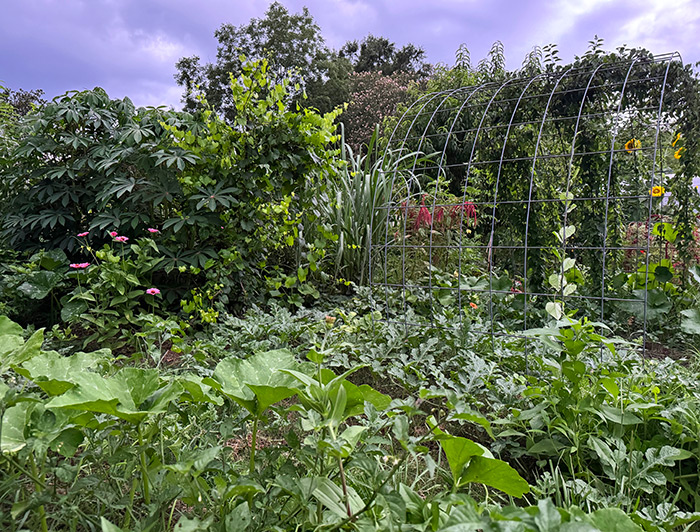Are plumeria poisonous to cats? The answer is technically yes, according to the USDA Forest Service and the Animal Poisons hotline of Australia. Plumeria are mildly toxic for people and pets according to the quotes below.
All parts of this shrub yield mildly poisonous alkaloids, which can affect those with sensitive skin. DO NOT TOUCH OR EAT flowers or any parts of this shrub as they may cause skin irritation or mild stomach pain and cramping in some people.
USDA Forest Service
However, similar reactions have been observed in cats.
The milky sap is irritating and chewing on or swallowing parts of the plant can result in gastrointestinal upset which may include irritation of the mouth, drooling, decreased appetite, vomiting and diarrhea. The iridoid and terpenoid toxins are particularly concentrated in the stem bark and therefore pets that have chewed on or swallowed the stem are more likely to develop symptoms than those that have chewed on or swallowed leaf or flower material.
Animal Poisons Hotline of Australia

About Plumeria
| Plumeria Plant Care Reference Card | |
| Common Name | Plumeria or Frangipani |
| Botanical Name | Plumeria spp. |
| Family | Apocynaceae |
| Plant Type | Tropical perennial shrub or small tree |
| Size | Typically 5 to 20 feet tall and wide, depending on type |
| Sun Exposure | Full sun |
| Soil Type | Well-drained, sandy, slightly acidic to neutral |
| Soil pH | Slightly acidic to neutral (pH 6.0 to 7.0) |
| Bloom Time | Spring through fall |
| Hardiness Zones | 10 to 12; often grown in containers in cooler climates |
| Native Area | Tropical regions of Central America, Caribbean, Mexico |
| Toxicity | Mildly toxic humans; mildly toxic to pets |
Are Plumeria Poisonous for Cats?
Yes, frangipani can be mildly toxic to dogs but some parts of the plants are more dangerous than others. As noted above the leaves or stem, rich in alkaloids, might lead to symptoms like vomiting and diarrhea if ingested. You should never let your pet’s chew, lick or ingest any parts of the plant. While plumeria are not as dangerous for animals as oleander or datura, there is still a possibility that they could become ill.
From my personal experience as lifelong cat owner, vomiting and diarrhea are difficult to stop in cats once those symptoms start. I’d rather be safe than see my animals in any sort of distress. My cats have never shown any interest in my plants. (Other than to pee or poop in them).
On the other hand, I did have a dog play with one. Holly (our husky puppy) unpotted a Celedine cutting and ran around the yard with it. My husband found it, fortunately Holly was okay and I think the cutting was too. It had roots so I repotted it, but only time will tell.
This sure taught me a lesson, but who would have thought that she would have gotten ahold of the potted cutting on a table?Maybe it blew over in the wind or maybe she’s just too smart (and naughty) for her own good.

Signs of Poisoning
In the event your cat gets ahold of one of your plumeria, these are the warning signs of poisoning that you should look for:
- Drooling or foaming at the mouth
- Vomiting
- Diarrhea
- Lethargy or weakness
- Irritated skin, redness or rash
Next Steps
- Remove the potential source of poisoning: If you think your cat has come into contact with a plumeria plant. it’s important to quickly remove any traces of sap from the skin.
- Gently wash the affected area with soap and water to remove the sap, and avoid touching other parts of the skin, which can potentially spread the sap and worsen the irritation.
- Deal with gastrointestinal symptoms: In cases where plumeria has been ingested, monitor your pet for vomiting and diarrhea.
- Seek medical attention: If symptoms are severe, it’s crucial to seek veterinary attention.
Grow Plumeria Safely
For best results make sure to take the following precautions:
- Supervise children and pets near plumeria plants to ensure they don’t ingest the branches, leaves or flowers
- Be mindful of allergic reactions, especially if you or someone in your household has sensitive skin.
Keep plants out of reach. Use gloves when handling the milky sap, supervise pets and educate family members about the plant’s characteristics.

Conclusion
In closing, yes parts of the plumeria plant are considered toxic for your pet. But now you know what to watch for and what actions to take if you suspect your cat has been chewing on or eating plumeria branches, stems or bark.




